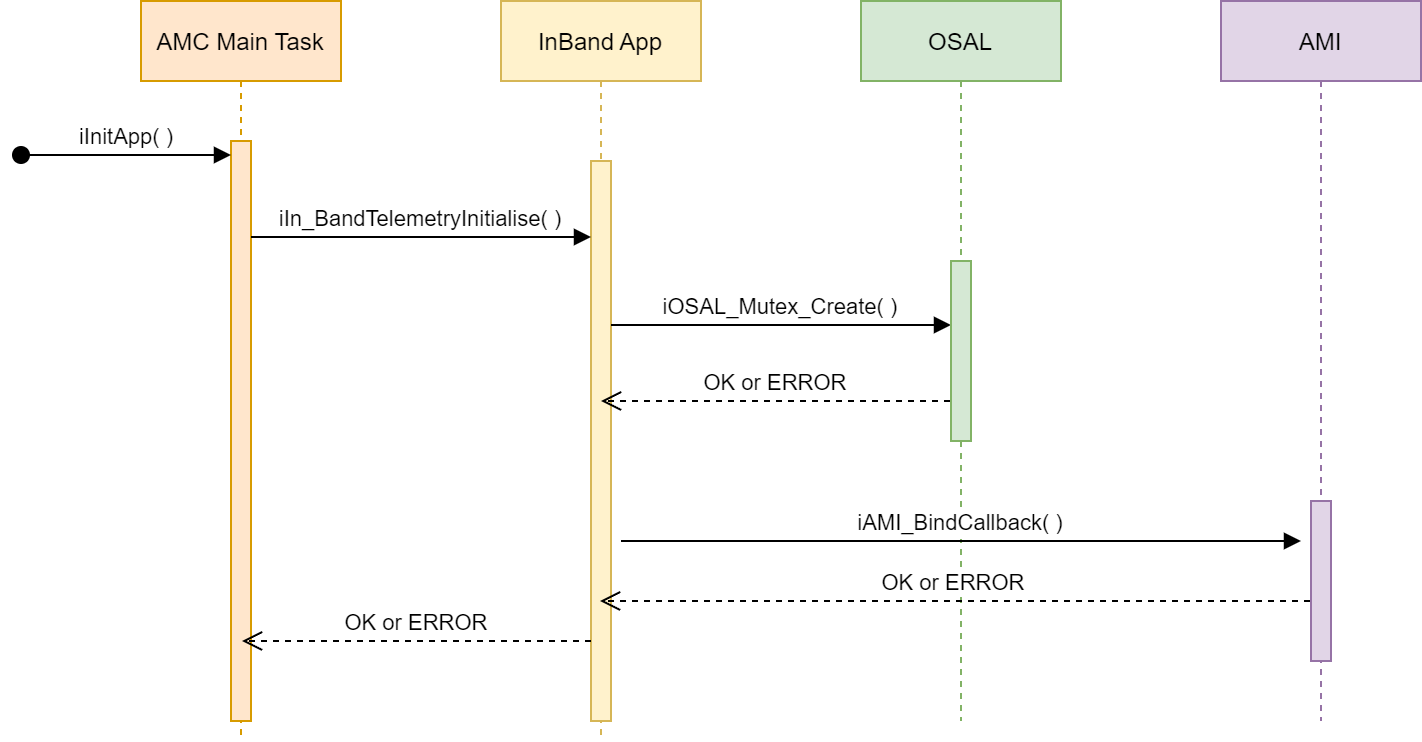AVED InBand Telemetry Application¶
Overview¶
The In-Band Telemetry application handles the events and communication between the Host and the ASDM data.
Application External APIs¶
Initialize the application.¶
The initialization function takes two parameters:
The shared memory address, which is used to populate the sensor responses.
The number of sensors in the profile, used internally to dynamically allocate some structures.
iIN_BAND_TELEMETRY_Initialise
/**
* @brief Initialise the in band telemetry application layer
* used to handle events and communication between the host
* and the sensors
*
* @param ullSharedMemBaseAddr The base address of the shared memory
*
* @return OK Success
* ERROR Failure
*/
int iIN_BAND_TELEMETRY_Initialise( uint64_t ullSharedMemBaseAddr );
Print Statistics¶
Debug function used to display the statistic counters and errors.
iIN_BAND_TELEMETRY_PrintStatistics
/**
* @brief Print all the stats gathered by the application
*
* @return OK Stats retrieved from proxy driver successfully
* ERROR Stats not retrieved successfully
*
*/
int iIN_BAND_TELEMETRY_PrintStatistics( void );
Clear Statistics¶
Debug function used to clear the all statistics counters back to zero.
iIN_BAND_TELEMETRY_ClearStatistics
/**
* @brief Clear all the stats in the application
*
* @return OK Stats cleared successfully
* ERROR Stats not cleared successfully
*
*/
int iIN_BAND_TELEMETRY_ClearStatistics( void );
Test Mode¶
Function for enabling and disabling the test mode for InBand Telemetry
iIN_BAND_TELEMETRY_TestMode
/**
* @brief Activating/Deactivating Test Mode
*
* @param iActivate Setting test mode activated or deactivated
* TRUE for activating
* FALSE for deactivating
*
* @return OK Test mode is activated/deactivated successfully
* ERROR Test mode is not activated/deactivated successfully
*
*/
int iIN_BAND_TELEMETRY_TestMode( int iActivate );
Internal Design¶
Structures¶
Internal Context structure
IN_BAND_PRIVATE_DATA
/**
* @struct IN_BAND_PRIVATE_DATA
* @brief Structure to hold ths in band telemetry private data
*/
typedef struct IN_BAND_PRIVATE_DATA
{
uint32_t ulUpperFirewall;
void *pvOsalMutexHdl;
uint64_t ullSharedMemBaseAddr;
uint32_t pulStatCounters[ IN_BAND_STATS_MAX ];
uint32_t pulErrorCounters[ IN_BAND_ERRORS_MAX ];
int iInitialised;
int iInBandTestMode;
uint32_t ulLowerFirewall;
} IN_BAND_PRIVATE_DATA;
iIN_BAND_TELEMETRY_Initialise Function¶
This function:
Creates a mutex.
Binds into the AMI to get sensor requests from the host.
iAmiCallback Function¶
This function is the bound in callback from the AMI Proxy to listen for the ‘AMI_PROXY_DRIVER_E_SENSOR_READ’ event.
When received, the application will call back into the AMI proxy to get the data associated with the request.
The request type (below) is then used to form up the response back from the internal ASDM table.
| AMI Proxy Request Type | In Band handling function | Description |
|---|---|---|
| AMI_PROXY_CMD_SENSOR_REQUEST_GET_SIZE | iASDM_PopulateResponse | Return the size of the SDR, including Header, Sensor Records and End of Repo marker |
| AMI_PROXY_CMD_SENSOR_REQUEST_GET_SDR | iASDM_PopulateResponse | Return the entire SDR – Header, Sensor Records and End of Repo marker |
| AMI_PROXY_CMD_SENSOR_REQUEST_GET_SINGLE_SDR | iASDM_PopulateResponse | Return the instantaneous sensor data based on the input sensor ID |
| AMI_PROXY_CMD_SENSOR_REQUEST_ALL_SDR | iASDM_PopulateResponse | Return the instantaneous sensor data for all sensors in a given SDR |
Page Revision: v. 26
